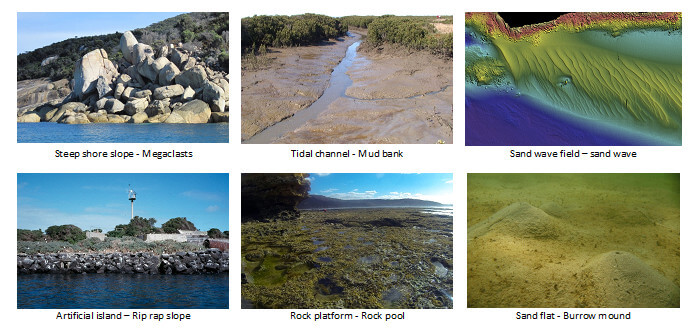The geoform component provides a hierarchical multi-scale classification of seabed and coastal morphology.

Benthic biotopes are highly influenced by geoforms. Geoforms vary in nature according to the relative composition of geoform elements, such as ridges, hollows, slopes, scarps, outcrops and the like. Each geoform element influences biota according to the nature of vertical and horizontal faces for attachment, influences on water movements and turbulence and the provision of interstitial spaces, such as crevices or boulder junctions.
The Coastal and Marine Ecological Classification Standard (CMECS) provides a systematic classification of geoforms that is based on two relative size scales. It also provides classes for tectonic setting, physiographic setting and geoform origin. The EUNIS-JNCC system also incorporates geoform classes in the upper levels of their biotic hierarchy. For example, ‘rock cliffs, ledges and shores’ are separated from unconsolidated coastal geoforms at a high level.
The CBiCS geoform component draws these two approaches together. The CMECS paramaters are represented directly within CBiCS, with the exception that larger scale geoforms described in CMECS were moved from the geoform hierarchy to the physiographic setting parameter. The upper levels of the CBiCS geoform hierarchy replicate that of the upper levels of the biotic component (and EUNIS). Classes within the lower levels of the geoform hierarchy were defined and calibrated in accordance with equivalent levels in the biotic component.
The CBiCS geoform component includes a standardisation of terminology for coral reef structures. There is presently no common terminology for temperate reef structures and CBiCS has initiated a system for bedrock geoform classes that relate to biotopes. The CBiCS concept is summarised as follows:
- Just as a biotope is composed of a particular assemblage of taxa, so a reef geoform is composed of a complex (assemblage) of geoform elements (e.g. pinnacles, gullies, pavements, ridges, walls).
- Geoform elements are comprised of combinations offaces and textures (e.g. horizontal reef tops, vertical faces, ledge undercuts).
- Just as a biotope can be described by scoring the frequency occurrence of morphotypes and indicator species, so a reef geoform can be described on the basis of its composite elements.
- Remote sensing of faces and geoform elements can be used to map and delineate geoforms.
- At larger spatial scales, bathymetry and other indicators of large scale features can be incorporated into the classification as part of the physiographic setting parameter.
Geoform Hierarchy Explorer
The geoform component hierarchy can be explored by clicking here.
At the time of publishing, the CBiCS geoform hierarchy for subtidal bedrock was relatively incomplete. considerable work is presently underway to describe bedrock geoform classes relevant to biotopes. Revisions will be updated here and please contact CBiCS for further information.
Key CBiCS Distinctions
- The CBiCS geoform component is based on a merger of CMECS and JNCC/EUNIS parameters, with adaptations to maintain the linkage between geoforms and predictability of biotopes.
- A system for classifying temperate reef geoforms associated with biotopes has been included.
- CBiCS extends the physiographic setting of CMECS to include common seascape and landscape classes and complexes of geoforms that do not fit within the geoform hierarchy and are well above the spatial scale of biotopes, such as atolls, deltas, canyons, continental shelfs and other large scale features.
Definitions
CBiCS will update and maintain and update a dictionary of standard terminology used in each component.
Classification of common physiographic settings and seascape features are provided by Harris et al. 2014 (PDF, 7MB).
